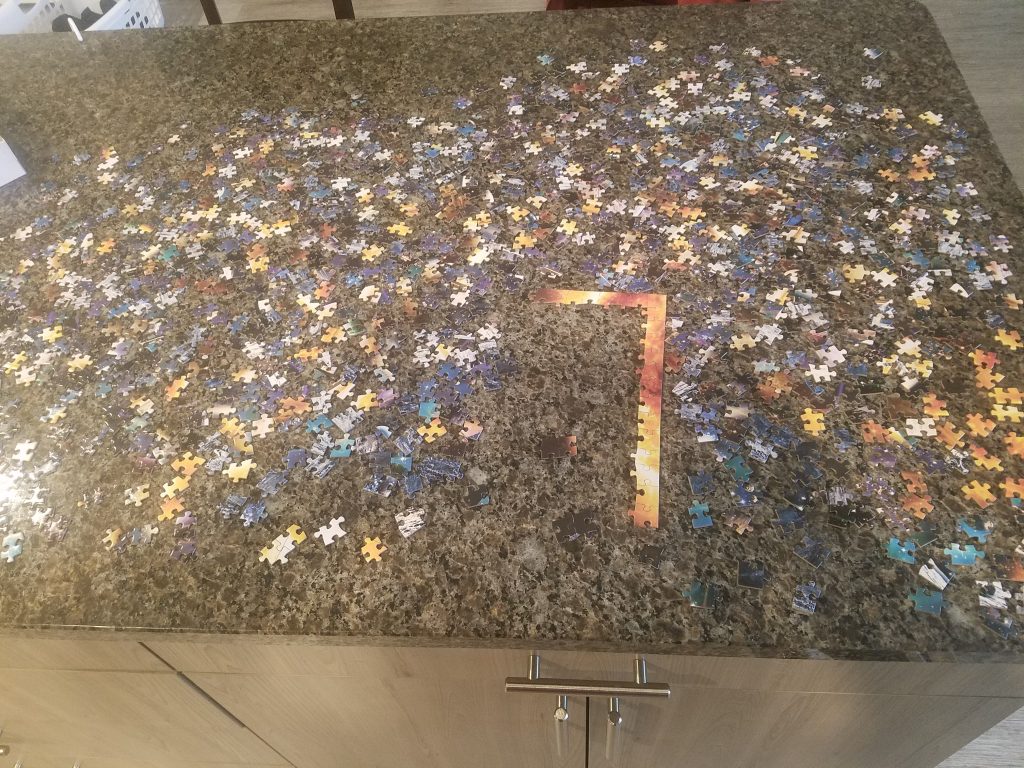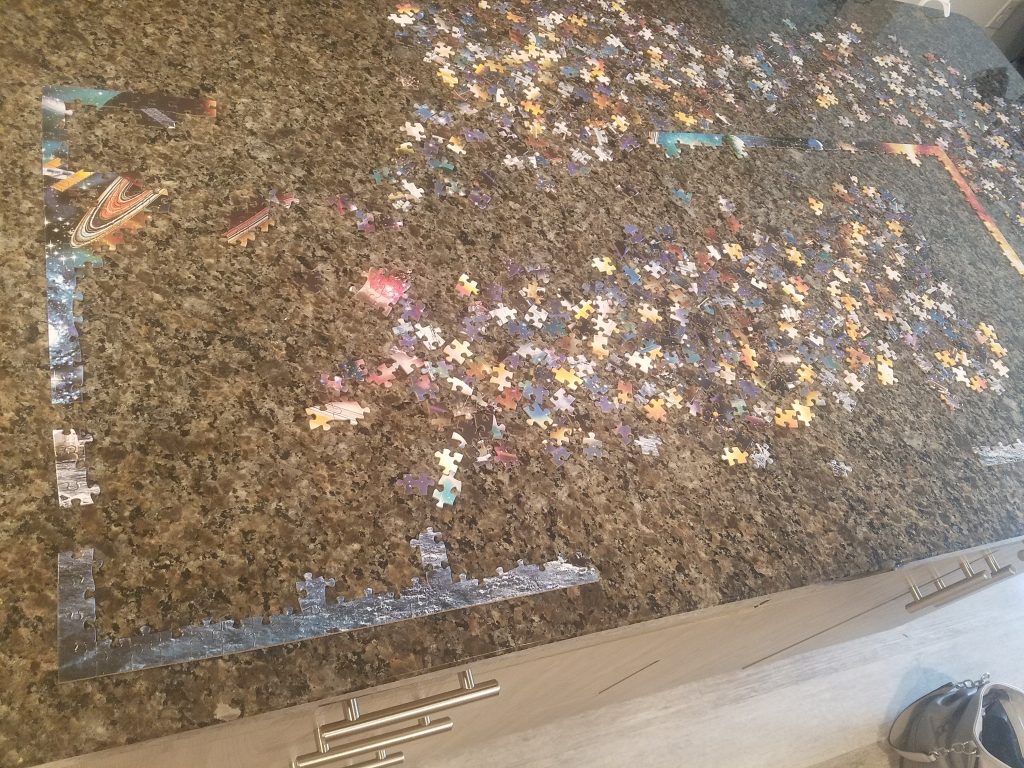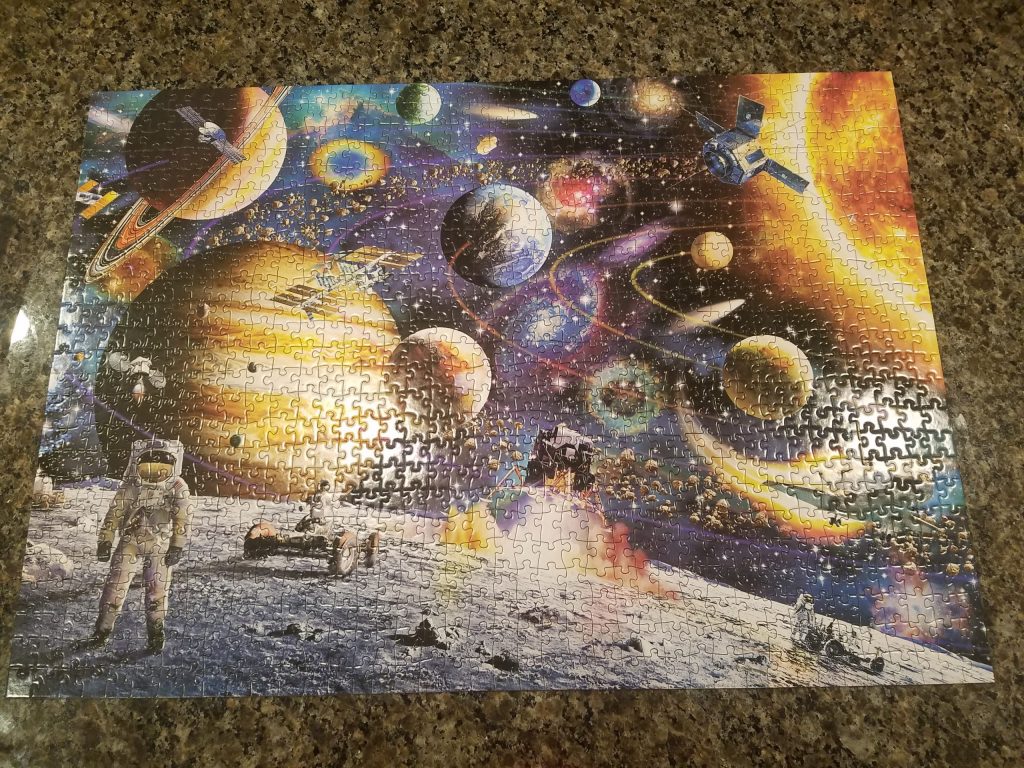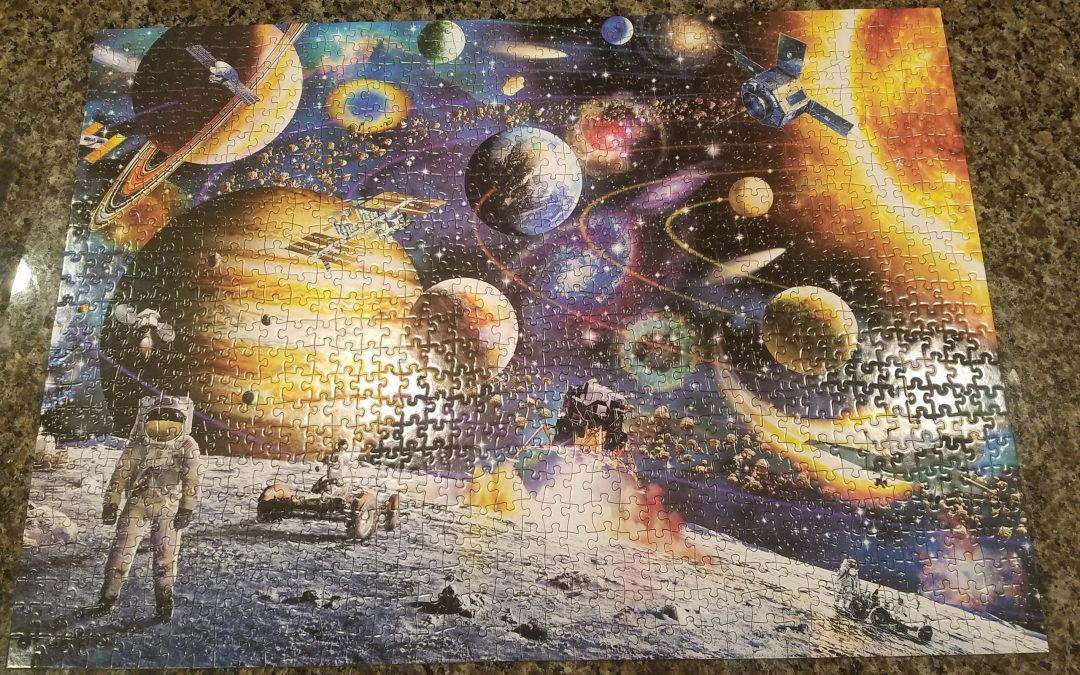For Christmas I bought Dan and me a 1000-piece jigsaw puzzle (among other things) with “space” images. I’ve been so busy this quarter, I haven’t had a chance to write this blog post until now.
I’m not a puzzle person, but I’m a fan of doing new things with my significant other, just to experience each other in new ways.
We dumped the pieces onto our kitchen island and started working on it.

First step was to turn over all the pieces, so we could see all of them. (Be aware of where you are.)
Meanwhile, we collected the “end” pieces all into one pile. (Have a strategy for where you want to go.)
We intuitively started working on the easiest sections that caught our eye first. For me, I started putting together Saturn’s rings first. Dan started working on the sun first. (Pay attention to what you’re drawn to.)

I expected it to take us a week to finish the puzzle. But we knocked it out in four days. (Be flexible with expectations.)
During the first round, I noticed how my mind was behaving towards the puzzle.
I noticed my mind getting obsessed about it. First thing in the morning, I’d start working on the puzzle instead of doing my highest-priority task. I’d continue working on it for too long, ignoring my conscience saying, “Ok, it’s time to stop and go do paid work now…”
One or two hours later, I still didn’t want to stop.
Not being able to stop myself was a problem.
(Addictions, vices, and bad habits pull us away from our most meaningful work.)
By the time 1-2 hours had passed, my shoulders were sore, my feet were tired from standing, and my eyes were fried from staring at puzzle pieces.
And…my high-priority tasks got pushed to the side.
“This is literally self-abuse.”
I was so burned out from the puzzle, I took the next day off and ignored it completely. Dan worked on it while I avoided it.
Then day 3 came… and I said, “I’ll work on it for 10-minute blocks today. I’ll practice stopping when the timer goes off.”
It was hard to stop. Because every time I linked up two pieces together, I got that dopamine hit…like I had achieved something. Satisfaction.
This act of doing the puzzle quickly became an exercise in controlling and disciplining my own mind.
I wasn’t going to be a victim of the puzzle or my desire to work on it beyond the scope I had set for myself. I was going to master this.
By that point, we had finished the puzzle.

I wanted to try the experiment again.
After savoring the completed puzzle for a couple days, I broke it apart and began the process all over again.
Dan had lost interest in repeating it, so I was the one putting 95% of the puzzle together during round 2. (He was already better at controlling his mind than I was at controlling mine, so this exercise was less appealing to him.)
…I put the puzzle together two more times, as an exercise in controlling my mind.
I set different rules for myself each day. Then I tested myself to see if I’d follow them or break them.
- “Today, I’ll work in 10-minute chunks on the puzzle and then STOP.” Sometimes my mind wanted me to keep going and it was “painful” to stop, because it was pleasurable to do the puzzle.
- “Today I’ll do 5 minutes of the puzzle every time I finish an important work-related project.” Limiting the puzzle work time to 5 minutes was often frustrating, because I didn’t achieve any momentum. But I got lots of high-priority work done.
- “Today I’m not going to work on the puzzle at all.” That was hard, because sometimes I’d walk into the kitchen for something, and my eyes and fingers would automatically gravitate to the puzzle without thinking. “Ah shit. Nope. Can’t work on that today.”
- And the most satisfying: “Today I’ll give myself 1 hour work on this puzzle.” I relished the longer time. I got deeper into it, put lots of pieces together, and smashed through it. When the hour was up, I was ready to take a break.
I learned that what I’m really after is that feeling of accomplishment, of getting something done, of putting “two pieces” together — but in the form of my business work. I could transfer this to book writing, client work, and anti-marketing work.
Fact is, putting a puzzle together can be tedious, annoying, and time-consuming. It requires patience and focus (as does anything that’s worth doing in life). There’s a level of satisfaction that comes when you’re done, and also a slight feeling of sadness when it’s over.
There’s also a period of wanting to stand back, look at, and admire what you’ve done for a while (i.e., not wanting to put the puzzle away for a few weeks after you’ve finished it).
It’s a great exercise overall to tame your mind and practice self-discipline — which also happens to my theme for 2021.
I invite you to try this experiment for yourself. Buy a 1000-piece puzzle that looks fun, put it together 1-3 times… and see what you learn about your mind in the process!
- Do you get angry at the puzzle?
- Do you get “bored”?
- Do you lose interest and quit?
- Are you impatient?
- Do you methodically work on it for a specific amount of time each day, compartmentalizing it with your other activities?
- Do you get obsessed, latch onto it mentally like a pit-bull, and abandon your other priorities?
- Do you get lost and confused, thinking you’ll never figure it out?
- How do these same behaviors show up in other areas of your life/business and cause you problems?
This is all great information to know about your own mind… so you can tame it, change it, and control if you want.
(Oh yeah, and the puzzle I bought was off Amazon. The original link is no longer there, but this looks like the same puzzle. Not sure if it’s the same seller.)


 Michelle Lopez Boggs is a copywriter, copywriting mentor, and author of "The Anti-Marketing Manifesto: How to Sell Without Being a Sellout." She's helped her clients sell millions of dollars' worth of products and services online by using the MEI(S) principle — motivate, educate, and inspire, and sell.
Michelle Lopez Boggs is a copywriter, copywriting mentor, and author of "The Anti-Marketing Manifesto: How to Sell Without Being a Sellout." She's helped her clients sell millions of dollars' worth of products and services online by using the MEI(S) principle — motivate, educate, and inspire, and sell. 